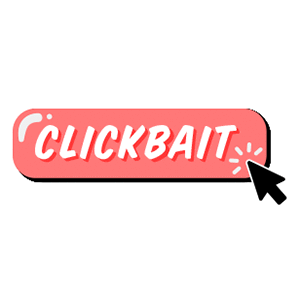What Is
Clickbait✔

Clickbait, a form of false advertisement, uses hyperlink text or a thumbnail link that is designed to attract attention and to entice users to follow that link and read, view, or listen to the linked piece of online content, with a defining characteristic of being deceptive, typically sensationalized or misleading. A "teaser" aims to exploit the "curiosity gap", providing just enough information to make readers of news websites curious, but not enough to satisfy their curiosity without clicking through to the linked content. Click-bait headlines add an element of dishonesty, using enticements that do not accurately reflect the content being delivered. The "-bait" part of the term makes an analogy with fishing, where a hook is disguised by an enticement (bait), presenting the impression to the fish that it is a desirable thing to swallow.
Long before the Internet, an unscrupulous marketing practice known as bait-and-switch used similar dishonest methods to hook customers. Like bait-and-switch, clickbait is a form of fraud. (Click fraud, however, is a separate form of online misrepresentation which uses a more extreme disconnect between what is being presented in the frontside of the link versus what is on the click-through side of the link, also encompassing malicious code.) The term clickbait does not encompass all cases where the user arrives at a destination that is not anticipated from the link that is clicked. When the manipulation is done for the purpose of humor, as with rickrolling, and there is no element of exploitation, then that deception does not qualify as clickbait.[citation needed] The term can also be misused when viewers complain about an enticing thumbnail or title, as with a sexually provocative image. But if the image or title accurately reflects the content delivered upon click-through, then this is an example of simple enticement. Without the element of deception, it does not qualify as clickbait. The borderline cases happen when a content creator inserts a very short segment in order to serve as justification for a provocative thumbnail, when the vast majority of the content has nothing to do with this short segment or thumbnail. Here, a strong case for clickbait can be made by any user, as the overriding characteristic is deception for the purpose of exploiting the user.
What Is ClickHole?
ClickHole is a satirical website formerly owned by The Onion that parodies clickbait websites such as BuzzFeed and Upworthy. It was launched on June 12, 2014, in conjunction with The Onion's decision to stop its print edition and shift its focus exclusively to the internet. According to ClickHole's senior editor, Jermaine Affonso, the website "is The Onion's response to click-bait content" and serves as "a parody of online media". Critics noted that, on a deeper level, ClickHole illustrates the shallow nature of social media content and media sites' desperation to share such content. On February 3, 2020, the website was acquired by the team behind Cards Against Humanity. After the purchase, the website's employees became its majority owners, and will retain complete creative control. As a result of the purchase, the website went on hiatus from February 3 to May 20.